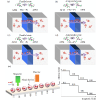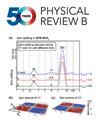多铁氧体隧道结中的自旋相关传输和多电阻态
IF 3.7
2区 物理与天体物理
Q1 Physics and Astronomy
引用次数: 0
摘要
多铁电体隧道结(MFTJ)由磁性电极和极薄的铁电体隧道势垒组成,是非易失性存储器应用的有力竞争者。具有打破时间反转对称极化特性的非共轭反铁磁性 Mn3Sn 和铁电性 α-In2Se3 为构建室温 MFTJ 提供了可能。在本研究中,我们利用第一原理计算研究了具有 Mn3Sn/BN/α-In2Se3/Mn3Sn 结构的 MFTJ 中的自旋相关传输。这种结构中的电阻可以通过调整 Mn3Sn 的奈尔矢量方向和 α-In2Se3 层的电极化方向来操纵。因此,可以实现多种隧道电阻态。我们预测,通过切换 Mn3Sn 的磁定向奈尔矢量,可以获得高达 6650% 的巨大隧穿磁阻;通过控制 α-In2Se3 的铁电结构,可以获得超过 8000% 的隧穿电阻。我们的研究强调了 Mn3Sn 在多铁性非易失性存储器中的潜在应用,并为利用反铁磁体开发超快、高效的自旋电子器件奠定了基础。本文章由计算机程序翻译,如有差异,请以英文原文为准。

Spin-correlation transport and multiple resistive states in multiferroic tunnel junctions
Multiferroic tunneling junctions (MFTJs), which comprise magnetic electrodes and extremely thin ferroelectric tunneling barriers, are promising contenders for nonvolatile memory applications. Noncollinear antiferromagnetic with time-reversal symmetry-breaking polarization properties and ferroelectric may open up the possibility of constructing room-temperature MFTJs. In this study, we investigate the spin-correlation transport in the MFTJs with structure using first-principles calculations. The resistance in this structure can be manipulated by tuning the directions of both the Néel vector of and the electric polarization of the layer. Thus, multiple tunneling resistive states can be realized. We predict that huge tunneling magnetoresistance up to 6650% can be obtained by switching the magnetically oriented Néel vectors of , and more than 8000% tunneling electrical resistance can be obtained by controlling the ferroelectric structure of . Our work underscores the potential applications of in multiferroic nonvolatile memories and lays the foundation for the development of ultrafast and efficient spintronic devices utilizing antiferromagnets.
求助全文
通过发布文献求助,成功后即可免费获取论文全文。
去求助
来源期刊

Physical Review B
物理-物理:凝聚态物理
CiteScore
6.70
自引率
32.40%
发文量
0
审稿时长
3.0 months
期刊介绍:
Physical Review B (PRB) is the world’s largest dedicated physics journal, publishing approximately 100 new, high-quality papers each week. The most highly cited journal in condensed matter physics, PRB provides outstanding depth and breadth of coverage, combined with unrivaled context and background for ongoing research by scientists worldwide.
PRB covers the full range of condensed matter, materials physics, and related subfields, including:
-Structure and phase transitions
-Ferroelectrics and multiferroics
-Disordered systems and alloys
-Magnetism
-Superconductivity
-Electronic structure, photonics, and metamaterials
-Semiconductors and mesoscopic systems
-Surfaces, nanoscience, and two-dimensional materials
-Topological states of matter
 求助内容:
求助内容: 应助结果提醒方式:
应助结果提醒方式:


